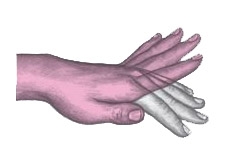PME is characterized by myoclonus, tonic-clonic seizures and progressive neurologic dysfunction, particularly ataxia and dementia. Myoclonus in PME is typically fairly severe and often precipitated by posture, action and sensory stimulation in a wide range of modalities. Some forms do not have cognitive impairment, which may be a useful diagnostic feature.
These are predominantly autosomal recessive disorders and are therefore commoner in countries where there is consanguinity.
The differential diagnosis includes:
1. The generalised epilepsies, in particular, juvenile myoclonic epilepsy, which in adolescent cases is frequently the first diagnosis before the progression becomes apparent.
Some patients with genetic generalised epilepsies who are overtreated with, in particular, sodium channel blockers, may resemble patients with PME. If toxicity arises from anticonvulsants, this may result in ataxia, uncontrolled seizures and cognitive impairment.
2. The epileptic encephalopathy’s, such as as the Lennox-Gastaut syndrome and Dravet syndrome. The epileptic encephalopathies are characterized by various forms of generalized seizures, including myoclonic seizures, but frequently have a fixed neurological deficit, although the illness may progress in some cases. PME can usually be distinguished from secondary generalized epileptic encephalopathies by a history of normal development followed by a relatively rapid progression of symptoms after the illness starts. Children with epileptic encephalopathies have a progressive disorder with intellectual impairment, but the clinical pattern and rate of decline is very different from PMEs overall.
3. Progressive encephalopathies with seizures.
In these conditions, primarily the disorder is that of a progressive dementia, seizures being secondary to the underlying process, resulting in the cognitive impairment. An example would be Tay-Sachs disease.
4. In adults, in particular the progressive myoclonic ataxias have clear overlap with PME. In this case, the pattern is dominated by ataxia and myoclonus, rather than epileptic seizures, noting that sometimes within the same family, such disorders may give rise to either PME or PMA.
5. FAME (Familial Adult Myoclonic Epilepsy)
Note that many neurological degenerative disorders, in particular, triplet codon repeat disorders and mitochondrial disorders, can initially, or when presenting early on, have a seizure disorder predominantly.
However, when presenting later in life the condition may present with a movement disorder. Examples include Huntington’s, DRPLA and mitochondrial disorders, which early on might present with a florid PME.
|
|
|
|
|
|
|||
Early |
Dementia | Myoclonic seizures Tonic-clonic seizures |
Ataxia Myoclonus |
Late |
|
| Progression, especially ataxia or dementia |
|
Usual onset |
Early childhood | Later childhood or adolescence | Typically adult |
Major causes |
In adults: Alzheimer's disease |
Unverricht-Lundborg MERRF Lafora NCL |
MERRF SCA 2, 8, 14 etc Coeliac disease |
Causes of PME
(potentially more common causes in bold )
- Unverricht-Lundborg Disease
- Lafora Body Disease
- Neuronal Ceroid Lipofuscinoses
- Mitochondrial Disease (MERRF)
- Dentatorubral-pallidoluysian atrophy
- GM2 Gangliosidoses
- Sialidosis (neuraminidase deficiency)
- Neuroserpin Mutations
- Hallervorden-Spatz Syndrome
- Juvenile Neuroaxonal Dystrophy
- Action myoclonus-renal failure syndrome (SCARB2)
- Coeliac Disease
- Biotin Deficiency
- Gaucher Disease
- Angelman Syndrome
- Rett Syndrome
- Alzheimer disease
- Juvenile Huntington disease

